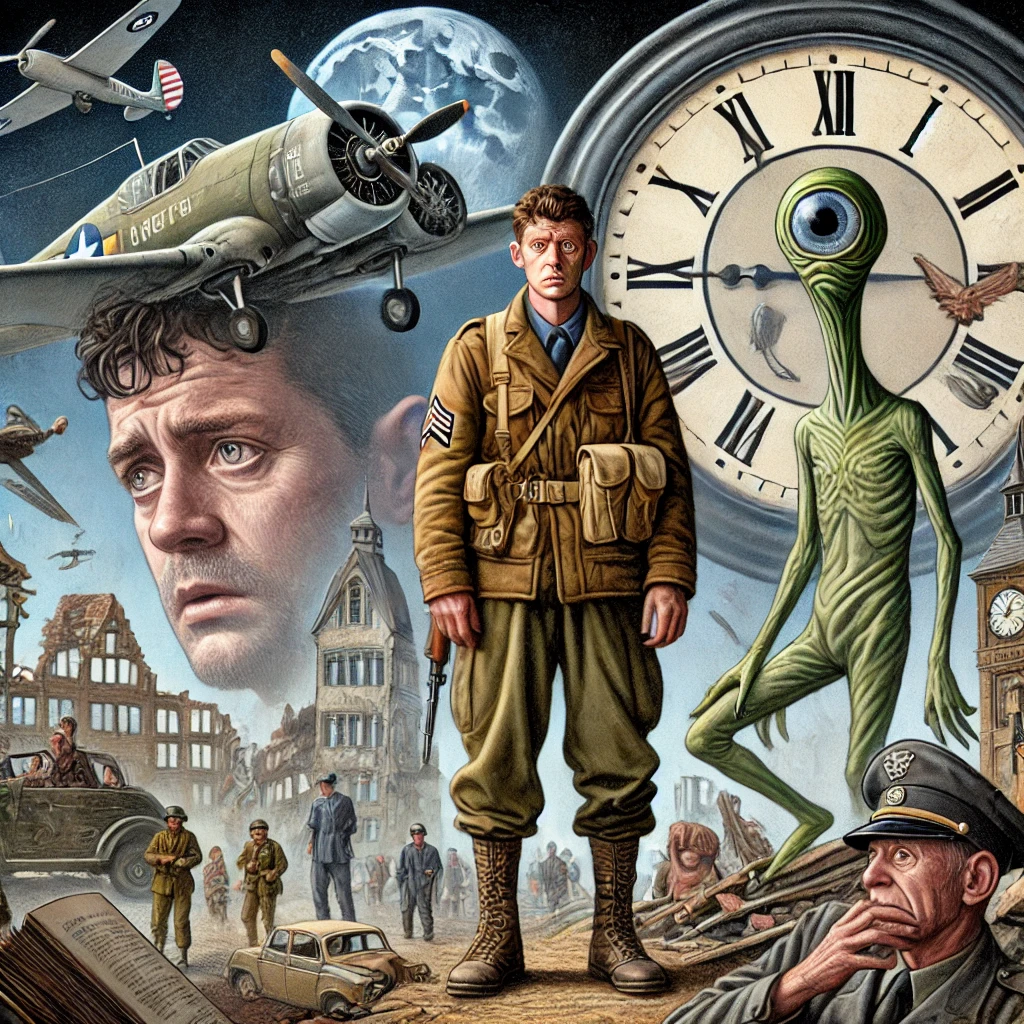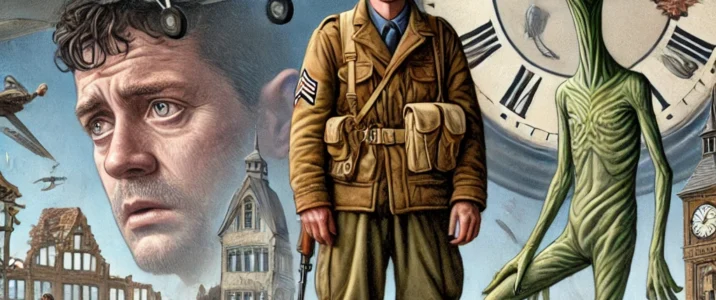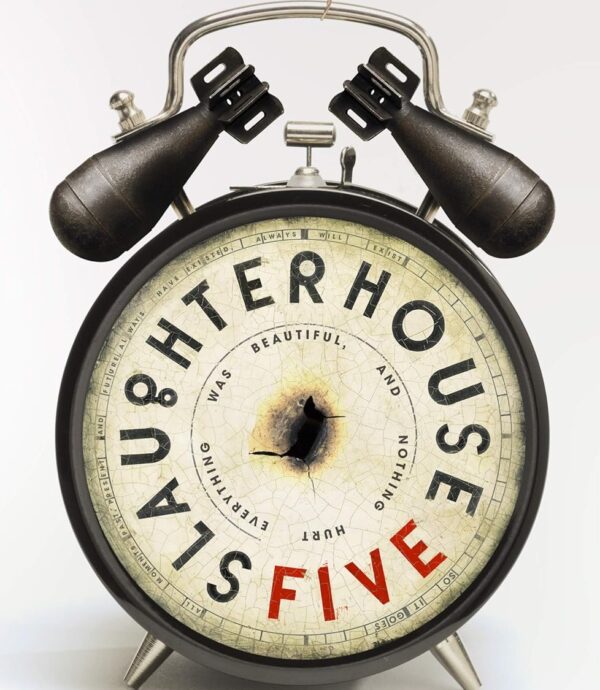Kurt Vonnegut’s “Slaughterhouse Five,” published in 1969, is a seminal piece of literature that has captivated readers with its unique blend of science fiction, historical narrative, and existential ponderings. This essay will delve into the plot, themes, and comparable works to fully appreciate the depth and impact of this novel.
Plot Summary
“Slaughterhouse Five” tells the story of Billy Pilgrim, a World War II veteran and optometrist who becomes “unstuck in time.” The narrative follows Billy’s life in a non-linear fashion, weaving together his experiences as a soldier, a prisoner of war, a husband, a father, and a captive of the extraterrestrial Tralfamadorians.
Early Life and War
Billy Pilgrim’s life begins in Ilium, New York, where he is a lanky, unassertive young man who stumbles through life. Drafted into the Army during World War II, Billy finds himself ill-prepared for the horrors of combat. He serves as a chaplain’s assistant, a role that positions him as an outsider among soldiers. His ineptitude in battle and his passive demeanor make him a target for ridicule.
Billy’s most significant wartime experience occurs during the Battle of the Bulge, where he is captured by the Germans. He and other POWs are transported to Dresden, where they are housed in a slaughterhouse (Slaughterhouse Five). Dresden is later bombed by Allied forces, an event that Billy survives by sheltering in a meat locker. This event, central to the novel, profoundly impacts Billy and symbolizes the senseless destruction of war.
Post-War Life
After the war, Billy returns to Ilium, where he finishes optometry school, marries the daughter of the school’s owner, and leads a seemingly ordinary life. However, Billy’s war experiences haunt him, leading to episodes of time travel where he revisits moments from his past and future.
Tralfamadorian Influence
Billy’s encounters with the Tralfamadorians, alien beings who perceive time differently, form another crucial aspect of the novel. The Tralfamadorians abduct Billy and place him in a zoo on their planet. They teach him their philosophy of time, viewing all moments as existing simultaneously. This perspective profoundly influences Billy’s understanding of life and death, making him a passive observer who accepts all events as inevitable.
Later Years and Legacy
In his later years, Billy becomes a public speaker, sharing his experiences and the Tralfamadorian philosophy. His daughter, Barbara, worries about his sanity, but Billy remains convinced of the truth of his experiences. The novel concludes with Billy anticipating his own death, accepting it with the same resignation that characterizes his entire life.
Kurt Vonnegut’s “Slaughterhouse Five” delves into numerous themes that collectively contribute to its status as a profound and enduring work of literature. The exploration of these themes offers readers insights into the human condition, the nature of time, and the absurdities inherent in the human experience. Below, we expand on the key themes of the novel:
The Absurdity of War
War as Chaos and Destruction: “Slaughterhouse-Five” presents war as an inherently chaotic and destructive force. The firebombing of Dresden serves as a poignant example of war’s senseless violence. Vonnegut’s depiction of the aftermath—a city reduced to ruins and countless innocent lives lost—highlights the indiscriminate and disproportionate devastation of warfare.
Human Powerlessness: The characters in the novel often appear powerless against the forces of war. Billy Pilgrim, as a passive participant, embodies this powerlessness. His capture, the brutal treatment of prisoners, and the random nature of death in war underscore the futility of individual efforts to influence or comprehend the vast machinery of conflict.
Dark Humor and Satire: Vonnegut uses dark humor and satire to critique the absurdity of war. The novel’s tone shifts between the tragic and the ridiculous, reflecting the irrationality of wartime experiences. Characters like the self-important, incompetent officer Roland Weary and the pompous British POWs exemplify the absurd characters and situations that war can produce.
The Nature of Time
Non-linear Narrative: Vonnegut’s choice of a non-linear narrative structure mirrors the novel’s central theme of time. By presenting events out of chronological order, he challenges readers to reconsider their conventional understanding of time. This structure also mimics the fragmented and disoriented state of a traumatized mind, as experienced by Billy.
Tralfamadorian Philosophy: The Tralfamadorians, with their ability to see all moments simultaneously, offer a radical perspective on time. They view time as a series of fixed events, each existing permanently. This view negates the traditional human perception of past, present, and future, suggesting that every moment is eternal and unchangeable.
Determinism vs. Free Will: The Tralfamadorian philosophy implies a deterministic universe where free will is an illusion. Billy’s acceptance of this perspective leads him to a fatalistic attitude, as he believes that all events are predetermined. This raises questions about the extent of human agency and the possibility of altering one’s fate.

Fatalism and Free Will
Billy’s Passive Acceptance: Billy Pilgrim’s character is marked by a passive acceptance of events. He drifts through life, resigned to the belief that he cannot change his destiny. This fatalism is epitomized by his repeated phrase, “So it goes,” which he uses to acknowledge death and suffering without resistance or anger.
Contrast with Other Characters: Other characters in the novel exhibit varying degrees of agency and resistance. Roland Weary, for example, stubbornly clings to his delusions of heroism and control, despite his evident powerlessness. This contrast highlights the spectrum of responses to the human condition and the tension between acceptance and resistance.
Philosophical Implications: The novel invites readers to grapple with the philosophical implications of fatalism. If all events are predestined, what is the value of human effort and choice? Vonnegut does not provide definitive answers but encourages readers to reflect on these existential questions.
Trauma and Memory
Post-Traumatic Stress Disorder (PTSD): Billy’s experiences as a soldier and POW leave him with lasting psychological scars. His time travel episodes can be interpreted as symptoms of PTSD, as he repeatedly relives traumatic moments. Vonnegut uses Billy’s fragmented memories to illustrate the enduring impact of war trauma on individuals.
Coping Mechanisms: Characters in the novel employ various coping mechanisms to deal with trauma. Billy’s detachment and acceptance of Tralfamadorian philosophy can be seen as a way to make sense of his experiences. Other characters, like Kilgore Trout, use creativity and storytelling to process their trauma and impose meaning on their lives.
The Persistence of Memory: The novel explores how memories of traumatic events persist and shape individuals’ lives. Billy’s time travel suggests that traumatic experiences are never fully relegated to the past but continue to influence the present. This theme resonates with broader discussions about memory, healing, and the long-term effects of trauma.
The Search for Meaning
Existential Questions: Throughout the novel, characters grapple with the search for meaning in a seemingly indifferent universe. Billy’s journey reflects the existential quest for purpose amid suffering and death. The Tralfamadorian philosophy offers one answer, suggesting that meaning lies in accepting the inevitability of all moments.
Absurdism and Nihilism: Vonnegut’s depiction of an absurd and arbitrary world aligns with existentialist and absurdist philosophies. The novel questions whether traditional sources of meaning—such as religion, heroism, and rationality—can provide solace in the face of life’s randomness. The recurring phrase “So it goes” epitomizes a resigned acceptance of the absurd.
Human Connection and Compassion: Amid the novel’s bleakness, moments of human connection and compassion offer glimpses of meaning. Characters like Edgar Derby, who is executed for a trivial offense after surviving the horrors of war, embody the potential for dignity and empathy. Vonnegut suggests that while the search for ultimate meaning may be futile, small acts of kindness and solidarity can still provide value.
Alienation and Isolation
Billy’s Alienation: Billy Pilgrim is an outsider throughout much of his life. His passive demeanor and acceptance of his fate distance him from others. Even his experiences of time travel and encounters with the Tralfamadorians isolate him further, as no one else shares these experiences or understands his perspective.
Isolation in Society: The novel depicts various forms of isolation experienced by individuals in society. Billy’s post-war life is marked by a sense of alienation from his family and community. His daughter Barbara’s frustration with him and his patients’ perceptions of him as eccentric further underscore his isolation.
The Alienation of War Veterans: Vonnegut also addresses the broader theme of war veterans’ alienation from civilian life. The traumatic experiences of war create a divide between veterans and those who have not shared these experiences. This theme resonates with the experiences of many soldiers who struggle to reintegrate into society after returning from combat.
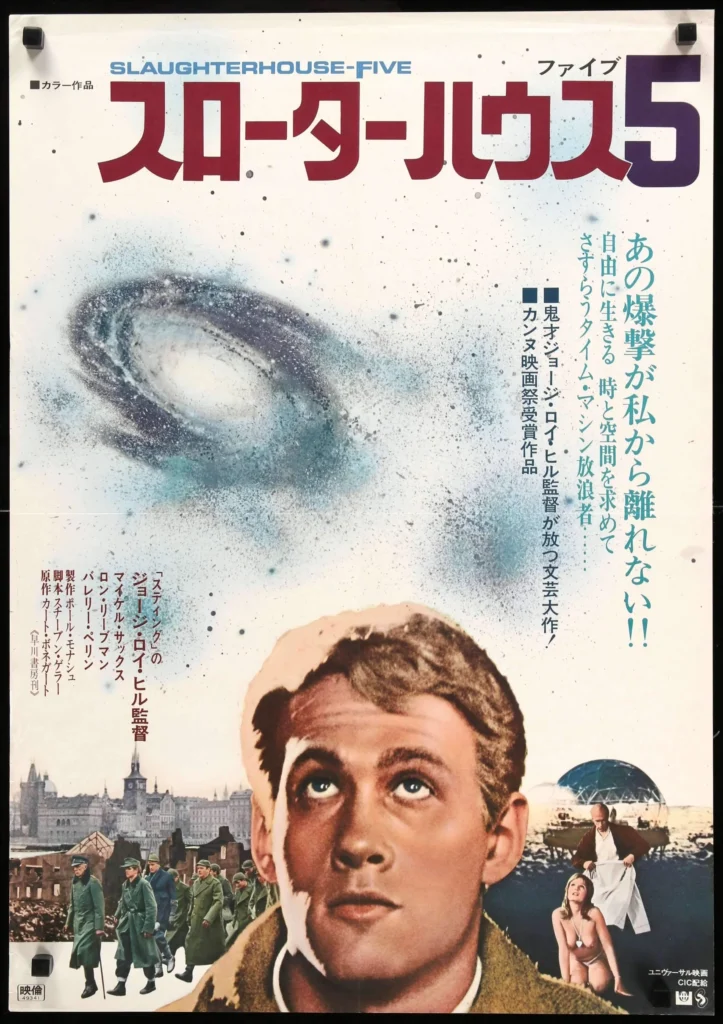
The Impact of Technology and Modernity
Technological Warfare: The novel highlights the destructive power of modern technology in warfare. The firebombing of Dresden, facilitated by advanced military technology, exemplifies the capacity for large-scale destruction. Vonnegut critiques the impersonal and dehumanizing nature of technological warfare.
Alienation through Technology: Modernity and technological advancements also contribute to alienation. The novel depicts a world where individuals are increasingly disconnected from each other, despite technological progress. This theme is reflected in the dehumanizing bureaucracies and impersonal institutions that pervade the novel.
The Role of Science Fiction: Vonnegut uses science fiction elements, such as time travel and extraterrestrial beings, to explore these themes. The Tralfamadorians’ advanced understanding of time contrasts with humanity’s limited perspective. This juxtaposition invites readers to consider the potential and limitations of human knowledge and technology.
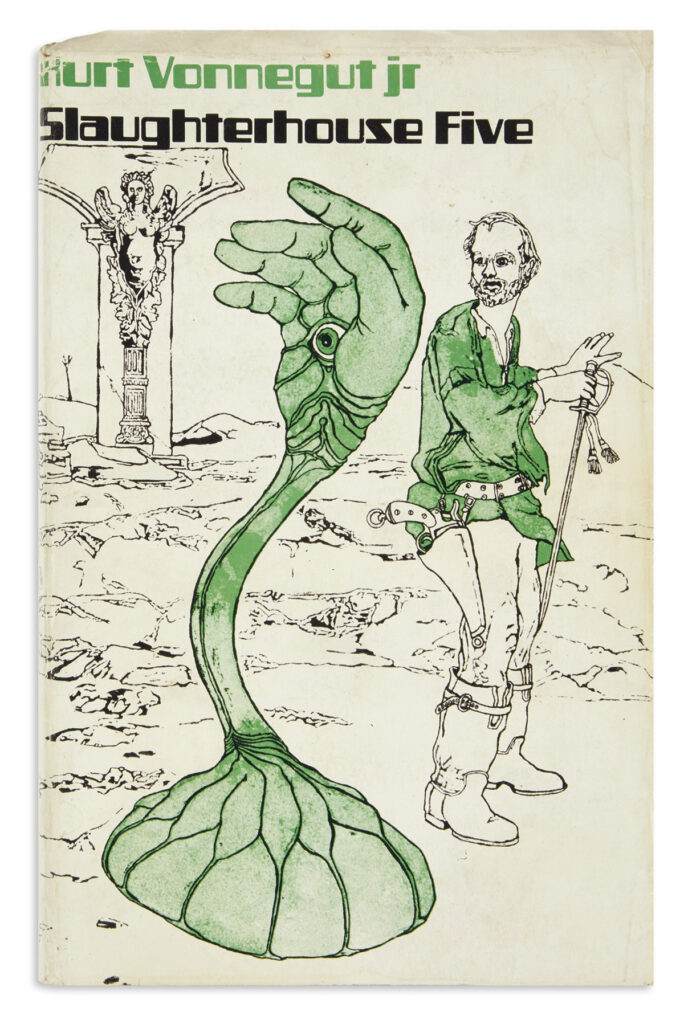
Morality and Ethics
Moral Ambiguity of War: “Slaughterhouse Five” presents war as a morally ambiguous phenomenon. The bombing of Dresden, while a strategic military action, results in the deaths of countless civilians. Vonnegut challenges the notion of clear-cut moral distinctions in war, suggesting that acts of violence and destruction often defy simple ethical categorization.
Ethical Responsibility: The novel raises questions about ethical responsibility in the face of inevitable events. If individuals are powerless to change their fate, as suggested by the Tralfamadorian philosophy, what is their ethical responsibility? Vonnegut does not provide easy answers but encourages readers to grapple with these complex ethical dilemmas.
Human Compassion: Amid the moral ambiguity, moments of human compassion and ethical behavior stand out. Characters like Edgar Derby, who exhibits moral courage and empathy, represent the potential for ethical action even in the most challenging circumstances. Vonnegut suggests that while the broader forces of war and fate may be beyond individual control, acts of kindness and compassion remain significant.
Religion and Spirituality
Religious Skepticism: Vonnegut expresses a skeptical view of traditional religious beliefs and institutions. The novel’s portrayal of religion is often critical, highlighting its limitations in providing comfort or meaning in the face of suffering and death. Characters like the pompous and hypocritical chaplain’s assistant reflect this critique.
Spiritual Exploration: Despite this skepticism, the novel explores spiritual themes through the Tralfamadorian philosophy. The aliens’ perspective on time and existence offers an alternative spiritual worldview that challenges conventional religious beliefs. This exploration invites readers to consider diverse spiritual perspectives and their implications for understanding life and death.
Existential Reflections: The novel’s existential themes intersect with spiritual questions. Characters grapple with the search for meaning and the acceptance of mortality, reflecting broader existential concerns. Vonnegut encourages readers to reflect on their own spiritual and existential beliefs in light of the novel’s themes.
Slaughterhouse 5, or The Children’s Crusade – A Duty-dance with Death
Read Kurt Vonnegut’s powerful masterpiece, which is as timely now as when it was first published. Travel through time and space on the shoulders of Vonnegut himself. This is a book about war. Listen to what he has to say: it is of the utmost urgency.
Similar Works
“Slaughterhouse Five” shares thematic and stylistic elements with several other works of literature, reflecting broader trends in postmodernism and war literature.
“Catch-22” by Joseph Heller
Like “Slaughterhouse Five,” Joseph Heller’s “Catch-22” (1961) is a satirical novel that critiques the absurdity of war. Set during World War II, it follows Captain John Yossarian, a bombardier who faces bureaucratic absurdities and the irrationality of military logic. Both novels use dark humor and non-linear narratives to convey their anti-war messages.
“The Things They Carried” by Tim O’Brien
Tim O’Brien’s “The Things They Carried” (1990) is a collection of linked short stories about a platoon of American soldiers in the Vietnam War. The book blurs the line between fiction and memoir, exploring themes of memory, trauma, and the nature of storytelling. Like Vonnegut, O’Brien delves into the psychological impact of war and the challenges of conveying its realities.
“1984” by George Orwell
George Orwell‘s “1984” (1949) explores themes of control, surveillance, and the manipulation of truth in a dystopian society. While not a war novel, “1984” shares Vonnegut’s concern with the dehumanizing effects of totalitarianism and the struggle to maintain individuality and sanity in oppressive conditions.
“One Hundred Years of Solitude” by Gabriel García Márquez
Gabriel García Márquez’s “One Hundred Years of Solitude” (1967) is a landmark of magical realism that weaves together the history of the Buendía family with elements of myth and fantasy. Like “Slaughterhouse Five,” it employs a non-linear narrative and explores the cyclical nature of time. Both novels challenge readers to reconsider conventional storytelling and embrace a more fluid understanding of reality.
Slaughterhouse Five
“Slaughterhouse Five” remains a powerful and thought-provoking novel, resonating with readers through its exploration of war, time, and human existence. Vonnegut’s masterful blending of genres and his ability to address profound themes with wit and humanity ensure that the novel continues to captivate and challenge audiences. By examining similar works, we can better appreciate the novel’s place within the broader literary landscape and its enduring impact on our understanding of the complexities of life and history.

